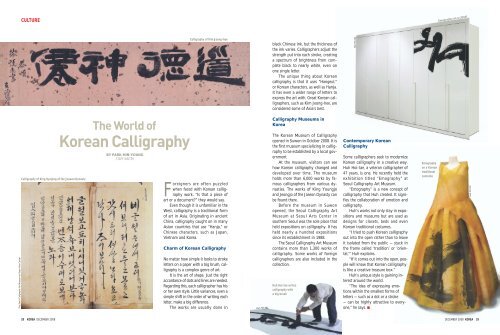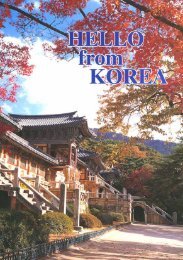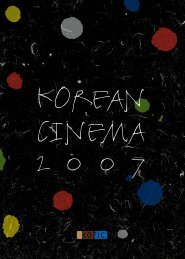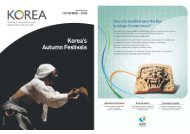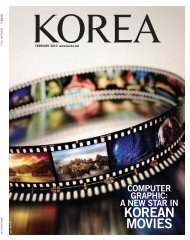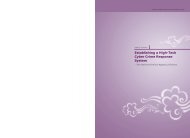Seoul Lights Up for the Holiday Season - Korea.net
Seoul Lights Up for the Holiday Season - Korea.net
Seoul Lights Up for the Holiday Season - Korea.net
You also want an ePaper? Increase the reach of your titles
YUMPU automatically turns print PDFs into web optimized ePapers that Google loves.
CULTURE<br />
Emography on a closet<br />
Calligraphy of Kim Jeong-hee<br />
black Chinese ink, but <strong>the</strong> thickness of<br />
<strong>the</strong> ink varies. Calligraphers adjust <strong>the</strong><br />
strength put into each stroke, creating<br />
a spectrum of brightness from complete<br />
black to nearly white, even on<br />
one single letter.<br />
The unique thing about <strong>Korea</strong>n<br />
calligraphy is that it uses “Hangeul,”<br />
or <strong>Korea</strong>n characters, as well as Hanja.<br />
It has even a wider range of letters to<br />
express <strong>the</strong> art with. Great <strong>Korea</strong>n calligraphers,<br />
such as Kim Jeong-hee, are<br />
considered some of Asia’s best.<br />
Huh Hoi-tae<br />
The <strong>Seoul</strong> Calligraphy Art Museum at <strong>Seoul</strong> Arts Center<br />
Calligraphy of King Hyojong of <strong>the</strong> Joseon Dynasty<br />
The World of<br />
<strong>Korea</strong>n Calligraphy<br />
BY PARK MIN-YOUNG<br />
STAFF WRITER<br />
Foreigners are often puzzled<br />
when faced with <strong>Korea</strong>n calligraphy<br />
work. “Is that a piece of<br />
art or a document?” <strong>the</strong>y would say.<br />
Even though it is unfamiliar in <strong>the</strong><br />
West, calligraphy is a traditional <strong>for</strong>m<br />
of art in Asia. Originating in ancient<br />
China, calligraphy caught on in many<br />
Asian countries that use “Hanja,” or<br />
Chinese characters, such as Japan,<br />
Vietnam and <strong>Korea</strong>.<br />
Charm of <strong>Korea</strong>n Calligraphy<br />
No matter how simple it looks to stroke<br />
letters on a paper with a big brush, calligraphy<br />
is a complex genre of art.<br />
It is <strong>the</strong> art of shape. Just <strong>the</strong> right<br />
accordance of dots and lines are needed.<br />
Regarding this, each calligrapher has his<br />
or her own style. Little variances, even a<br />
simple shift in <strong>the</strong> order of writing each<br />
letter, make a big difference.<br />
The works are usually done in<br />
Huh Hoi-tae<br />
Calligraphy Museums in<br />
<strong>Korea</strong><br />
The <strong>Korea</strong>n Museum of Calligraphy<br />
opened in Suwon in October 2008. It is<br />
<strong>the</strong> first museum specializing in calligraphy<br />
to be established by a local government.<br />
At <strong>the</strong> museum, visitors can see<br />
how <strong>Korea</strong>n calligraphy changed and<br />
developed over time. The museum<br />
holds more than 6,000 works by famous<br />
calligraphers from various dynasties.<br />
The works of King Youngjo<br />
and Jeongjo of <strong>the</strong> Joseon Dynasty can<br />
be found <strong>the</strong>re.<br />
Be<strong>for</strong>e <strong>the</strong> museum in Suwon<br />
opened, <strong>the</strong> <strong>Seoul</strong> Calligraphy Art<br />
Museum at <strong>Seoul</strong> Arts Center in<br />
sou<strong>the</strong>rn <strong>Seoul</strong> was <strong>the</strong> sole place that<br />
held expositions on calligraphy. It has<br />
held nearly a hundred expositions<br />
since its establishment in 1988.<br />
The <strong>Seoul</strong> Calligraphy Art Museum<br />
contains more than 1,300 works of<br />
calligraphy. Some works of <strong>for</strong>eign<br />
calligraphers are also included in <strong>the</strong><br />
collection.<br />
Huh Hoi-tae writes<br />
calligraphy with<br />
a big brush<br />
Contemporary <strong>Korea</strong>n<br />
Calligraphy<br />
Some calligraphers seek to modernize<br />
<strong>Korea</strong>n calligraphy in a creative way.<br />
Huh Hoi-tae, a veteran calligrapher of<br />
47 years, is one. He recently held <strong>the</strong><br />
exhibition titled “Emography” at<br />
<strong>Seoul</strong> Calligraphy Art Museum.<br />
“Emography” is a new concept of<br />
calligraphy that Huh created. It signifies<br />
<strong>the</strong> collaboration of emotion and<br />
calligraphy.<br />
Huh’s works not only stay in expositions<br />
and museums but are used as<br />
designs <strong>for</strong> closets, beds and even<br />
<strong>Korea</strong>n traditional costumes.<br />
“I tried to push <strong>Korea</strong>n calligraphy<br />
out into <strong>the</strong> open ra<strong>the</strong>r than to leave<br />
it isolated from <strong>the</strong> public — stuck in<br />
<strong>the</strong> frame called ‘tradition’ or ‘oriental,’”<br />
Huh explains.<br />
“If it comes out into <strong>the</strong> open, people<br />
will know that <strong>Korea</strong>n calligraphy<br />
is like a creative treasure box.”<br />
Huh’s unique style is gaining interest<br />
around <strong>the</strong> world.<br />
“The idea of expressing emotions<br />
within <strong>the</strong> smallest <strong>for</strong>ms of<br />
letters — such as a dot or a stroke<br />
— can be highly attractive to everyone,”<br />
he says. ■<br />
Emography<br />
on a <strong>Korea</strong>n<br />
traditional<br />
costume<br />
Huh Hoi-tae<br />
28 KOREA DECEMBER 2008<br />
DECEMBER 2008 KOREA 29


